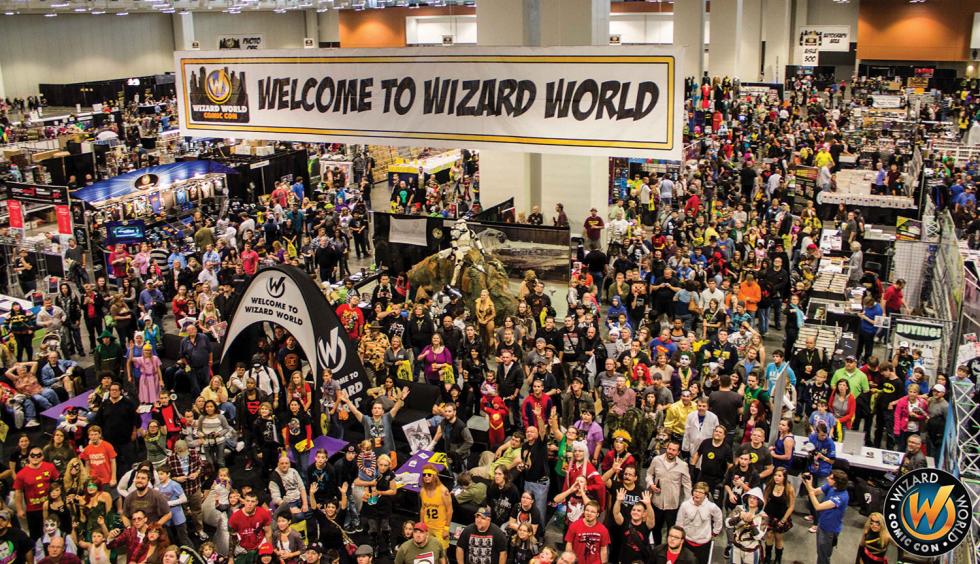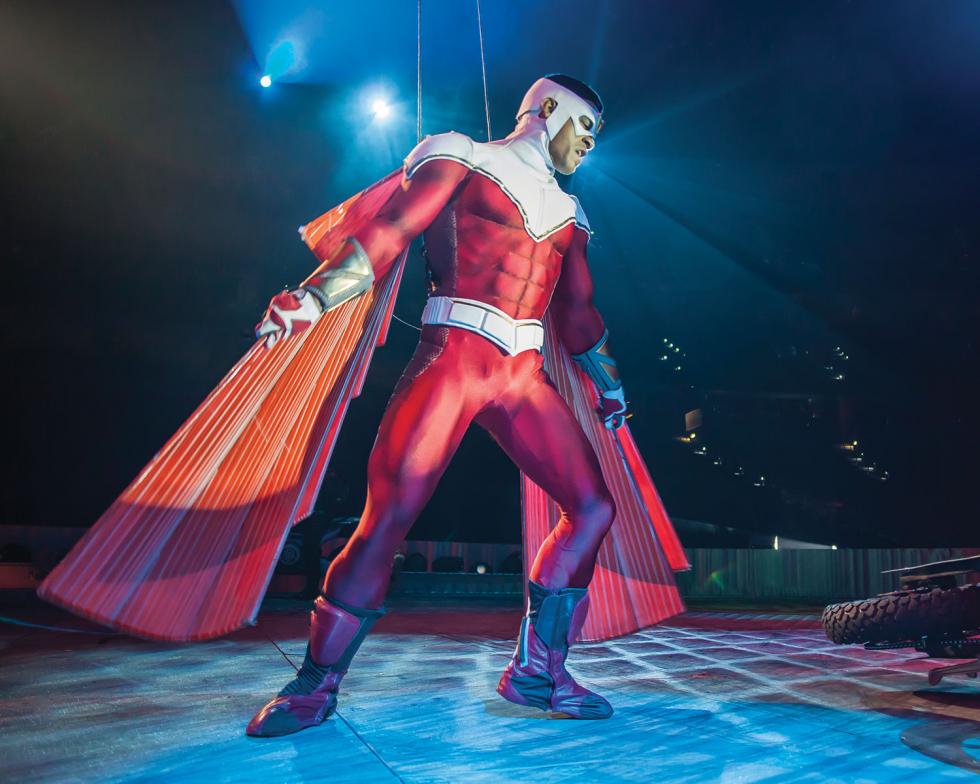On a Saturday in 2014, the line to enter the first ever Wizard World convention in Sacramento was four people wide and encircled the entire convention center.
Comic-themed conventions, or cons, have been around since the 1970s. Even the Capital Region has had its own Sac-Con since 1989. In those days, the events were small affairs attended by a hard-core smattering of lonely youth and middle-aged men speaking their own jargon-filled language. It was they who created and perpetuated the stereotype of the comic book nerd. But in the past five years, something changed. Cons became cool.
Publishers Weekly reports con attendance growing across North America by as much as 20 to 50 percent annually. According to Comics Beat magazine, these events constituted a $3 billion industry in 2013. That’s nearly four times the revenue of the entire comic publishing industry that same year. The only events that consistently sell more tickets are state fairs.
That’s been great news for host cities. San Diego, which hosts the Super Bowl of comic conventions — Comic Con International — attracts 130,000 visitors annually and sees $480 million in economic impact from the event. Many other large cons draw more than 50,000 people, so it’s no surprise cities are welcoming these functions, and Sacramento is no exception.
When Sac-Con hosted its first event in 1989, it was held in a ballroom at the Sierra Inn at Auburn and Interstate 80, and about 100 people attended. Fast forward to 2015. Sac-Con now holds four events a year and in March moved for the second time to a larger facility in the McClellan Conference Center. Sac-Con founder Dan Houck made the move from the Scottish Rite Center in Sacramento to accommodate larger crowds.
“Our average attendance at Scottish Rite would bring 1,500 to 2,500 attendees, and that was all we could handle,” says Houck, who also founded the semi-annual SacAnime event that attracts 14,000 fans of Japanese animation. “The move allowed us to double in size. We had 4,000 people at our first McClellan event — almost 1,000 more than we expected.”
Nearly 30,000 people attended Sacramento’s Wizard World
Convention, providing an economic impact of nearly $2 million,
according to the city’s convention and visitor’s bureau.
(Photo courtesy of Wizard World)

Mike Millerick, a native of Lodi, launched StocktonCon in 2012, which grew from 4,500 people to nearly 14,000 in just two years. StocktonCon has been so popular that Millerick, who donates proceeds from the events to the Salvation Army and United Way, also launched the Lodi Grape City Con in February.
Neither Houck nor Millerick could disclose hard numbers, but envelope math suggests all eight shows bring in about $600,000 annually from ticket sales, plus a modest amount for vendor booth sales. Those may not be Cadillac dollars, but they show a real demand here — strong enough to garner some big attention in 2013 and officially put the Capital Region on the con map.
“In Sacramento we saw a region we felt was underserved in the kind of show we do,” says John Macaluso, CEO of Wizard World, which did considerable market research in considering new venues.
Seeing the potential, the Sacramento Convention & Visitors Bureau courted Wizard World extensively to prove Sacramento could provide key event elements, including a walkable facility, strong hotel partners and desirable restaurant offerings. Even Mayor Kevin Johnson weighed in.
Related: Comic Crash — How offing Superman almost killed the comic industry
“Because of the high-profile success of similar events in other cities, it was a priority of mine to encourage the show to select Sacramento,” Johnson says. “Sacramento hosts hundreds of events — some are private and fly under the radar, some are public events that generate publicity for the city, provide entertainment for residents and drive significant revenues for local businesses. Wizard World is one of those shows.”
Historically, most of the hospitality money Sacramento imports has come from business travelers. They’re still a primary audience, but the CVB has stepped up efforts to attract more leisure travelers on weekends and holidays. Wizard World was right in the sweet spot and by all accounts a huge success.
“About 30,000 people attended the convention,” says Mike Testa, the CVB’s chief operating officer. “That translated into an economic impact of about $2 million for the city.”
Wizard World’s CEO was equally pleased. Although he would not disclose actual numbers, 30,000 people at roughly $45 per ticket translates to about $1.3 million in revenue.
“Sacramento was far and away the best first-year show we’ve ever done in terms of attendance, excitement and support from the city,” Macaluso says. “It was fantastic, and we can’t wait to come back in June with a bigger show.”
“Sacramento was far and away the best first-year show we’ve ever done in terms of attendance, excitement and support from the city. It was fantastic, and we can’t wait to come back in June with a bigger show.” John Macaluso, CEO, Wizard World
The local con scene wasn’t always this good. The early years were slow, and then the whole comic industry crashed in the mid ’90s. At the market’s height in 1993, the Sacramento region had nearly 40 comic book shops. When the worst was over, there were seven.
But a new era of comic interest rose about 10 years ago and began to spike around 2010. For local comic shop owners that survived the lean years — years when sometimes it wasn’t worth the time to set up a booth at a local con — the recent growth has been welcome.
“These shows are filled with our core audiences all in one place,” says Dave Downey, who owns World’s Best Comics in Sacramento. “They’re good money makers. In a given year I’ll do eight shows at a total cost of around $5,000 for space, and we do far beyond that in sales. Even if we didn’t, these events are a great way to get our name out there.”
It’s hard to identify the one thing that turned things around, but most observers agree that comics have evolved from disposable entertainment, as they were once known, into something with a deeper connection to mainstream popular culture.
“The success of the Marvel movies has pushed all of this to the forefront of popular culture,” says Brian Peets, owner of A-1 Comics in Sacramento and Roseville. “Convention organizers have turned their events into more of an entertainment venue, where you can meet artists, take pictures with movie stars and see sneak previews. It’s become an entertainment experience rather than just going from booth to booth, shopping.”
Cons have also diversified their offerings. Comics are still central, but cons now encompass all of “geek culture,” including anime, Star Trek, Star Wars, toys and video games. The result is broader appeal.
Importantly, that expanded audience now includes one demographic previously all but overlooked by the comic industry: women.
In 1994, 92 percent of DC Comics’ customers were men. Twenty years later, Comics Beat reported almost 47 percent of comic fans are women, and Macaluso says attendance at his events is evenly split among genders. Women themselves deserve much of the credit for turning things around — there are now far more of them writing, drawing and starring in the comics.
Even with the audience growth, the con boom might not have been so dynamic if not for Wizard World, which changed the game by taking the comic convention on the road.
Marvel Universe Live! packed Sleep Train Arena in March with
live-action comic book heroes and fans of all ages.
(Photo courtesy of Field Entertainment)

Indeed, if Comic Con International can sell 130,000 tickets in less than two hours, there’s money to be made by delivering cons to the people. Wizard World’s convention revenue was $19.1 million through the first 9 months of 2014, up from $8.8 million in the same period a year prior.
“I think the appeal and success of Wizard World’s shows is the level of access they give,” says Heather Atherton, a PR consultant and California/Nevada publicist for Wizard World. “People really enjoy the chance to get close to some big-name stars.”
As the bandwagon gets bigger and louder, however, it’s worth asking whether the market is growing saturated. From San Jose to Reno, there are no fewer than 12 in a year, and bigger shows are cropping up in almost every city. Wizard World alone is nearly doubling its event schedule in 2015.
The rise of big shows isn’t forcing the smaller shows out just yet; in some ways they’re even helping. But they are creating headwinds. “We’re well-established, and I’m lucky to have gotten in on the ground floor of this, but it will be hard to take Sac-Con to another level,” Houck says. “The growing number of shows has created more demand for special guests, and that’s making them expensive. Guests that used to charge $3,000 are now charging $15,000 and up. I can’t pay those costs and keep ticket prices low.”
The phenomenal growth in con attendance might not be sustainable, but no one’s expecting a crash as much as a leveling out in the future. Some fans will drift away, but people will always want to meet their heroes, real and imagined. Moreover, these events have become as much a community gathering — where people of similar interests meet up, dress up, and make new friends — as a niche entertainment offering.
No one’s worried about the next generation of fans either. Marvel and Star Wars are both owned by Disney, which mastered the art of winning children’s hearts generations ago. Plus, new traveling, family-friendly shows like Marvel Universe LIVE!, which packed Sacramento’s Sleep Train Arena in March, are ensuring today’s kids are tomorrow’s fans.
All of that is good for business for local con organizers and local comic shop owners who are seeing more customers and selling more product.
“I don’t think there are too many of these events at all, especially in northern California,” Peets says. “I’d say there aren’t enough.”



